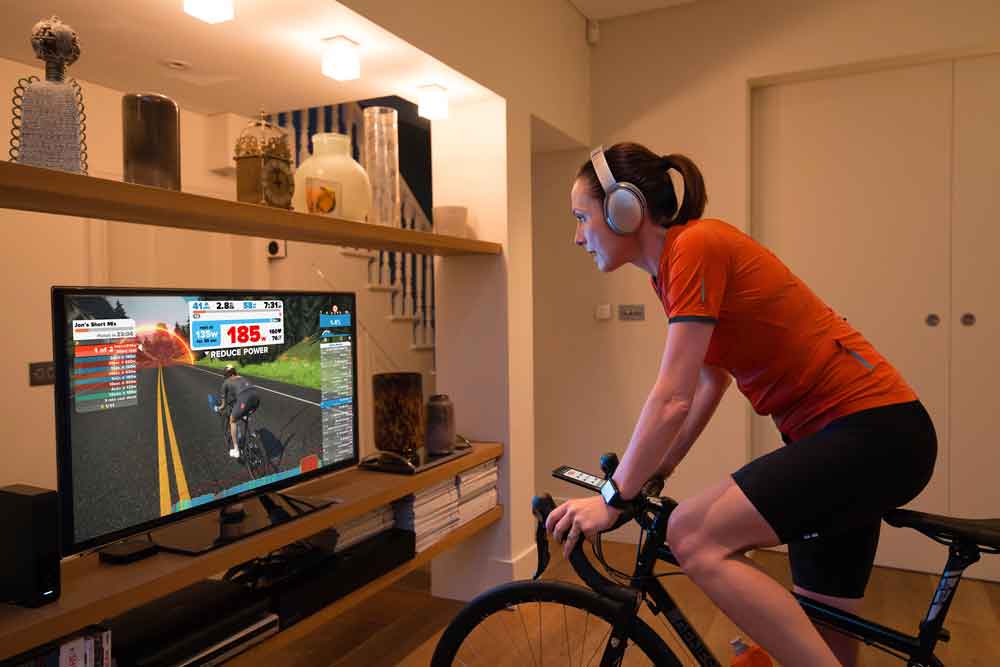How to Smash Indoor Training Sessions Like a Pro Cyclist

Perhaps no other cyclist in recent memory has utilized an indoor trainer with such great success as 39-year-old Aussie Matthew Hayman. After fracturing the radius bone in his right arm at the one-day spring cycling classic Omloop Het Nieuwsblad last February, Hayman found himself on the verge of missing out on the one race he coveted most: Paris-Roubaix.
However, Hayman discovered the interactive global cycling community Zwift and spent the next four weeks engaged in daily double indoor training sessions to maintain his form. He eventually returned to grab the biggest win of his career at the cobbled-classics’ most iconic UCI road race in Paris.
Just days after completing his second straight Tour de France, we spoke to Hayman to get the lowdown on how logging more than 600 miles on the indoor trainer helped him win one of cycling’s biggest prizes.
“I was always one of the guys who would prefer to ride in the rain and weather than get on the home trainer,” Hayman said. “I really didn’t like it, but now home trainers and the programs associated with them have improved so much so since I’ve turned pro that now I think twice about going out on the road.” Think: trainers like the Tacx Neo Smart with a road-like feel, and virtual rides and races.
For Hayman, indoor cycling means no-nonsense, efficient training at its finest.
“I was doing double sessions for four weeks, including intervals in the morning and endurance sessions in the evening—about an hour and a half to an hour and 45 minutes per session,” Hayman explained, who admitted his indoor sessions became “strangely addictive” over time. “It was a lot of intensity—no fluff at all.
From the time you hop on an indoor trainer you are never free-wheeling, so if you do an hour and a half, it’s an hour and a half of quality training.”
RELATED: Triathlete’s Guide to Indoor Training
Below, Six Pro Tips to Nailing—And Loving—Indoor Sweat Sessions
It’s Hard
“Occasionally, my coach will schedule in some indoor sessions during an intense phase of training usually to work on top end and as well as cadence. It’s by no means the soft option when ditching the rain for an indoor session (or two).”
— Sarah Roy, AUS, Orica-Scott
Zone Out
“Recently I’ve enjoyed the Think Fit Podcast by Tim Ford and Mike Robinson—two good Aussie triathletes who lost a combined weight of nearly 60 lbs. and discuss between themselves and professionals what works and what doesn’t in training and weight loss.”
— Roy
Get a Crew
“During the winter, we spend a ton of time on the rollers. One time, my sister Samantha and I did a complete six-hour ride without stopping. Our mom made us lunch and we ate it on the bike! It helps when you have someone there motivating you and keeping you company.”
— Skylar Schneider, USA, formerly Team Illuminate
Get Inspired
“I like to watch cycling on the trainer. When I saw my teammate Edvald Boasson Hagen was in the breakaway at the Tour de France, I set up the trainer and watched the final hour, totally amped up when he won. I’ve also put armrests on the handlebars and played video games, done language lessons, and read books on a music stand. The possibilities are endless.”
–Ben King, USA, Dimension Data
Drink Up
“It is easy to get dehydrated on the trainer. If you’re stuck inside for an extended period be careful not to dig a hole. My rule is generally two days on and then one day completely off to focus on replenishing fluids. Even if you’re having to get off the bike every 20 minutes to use the bathroom, keep drinking.”
–King
Stay Cool
“Even in winter in Belgium, it’s pretty cool and you can open the garage door, but just having a fan provides constant air flow and will reduce your heart rate quite a lot — unless you are looking for heat adaption of course.”
–Hayman
GO PRO
Hayman’s three favorite indoor trainer sets for developing power and endurance.
1
3×20 minutes with 10 minute recovery, between 80-95% of functional threshold power (Hayman says his FTP seems to be lower for him on the trainer)
2
3x(5×40 seconds on, 20 seconds off)
3
7×5 minutes with 1 minute recovery